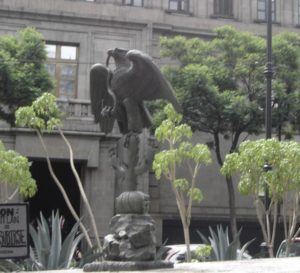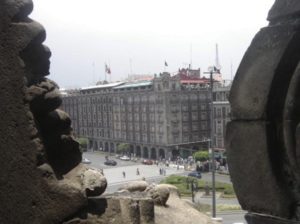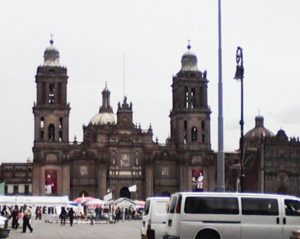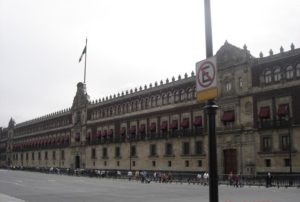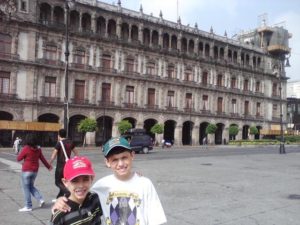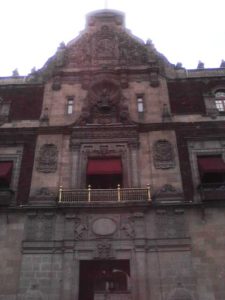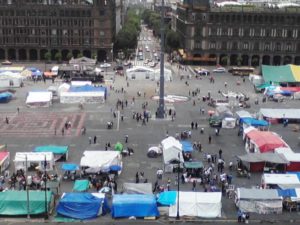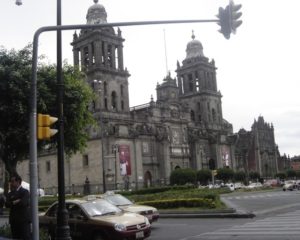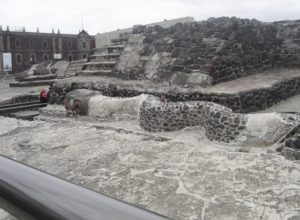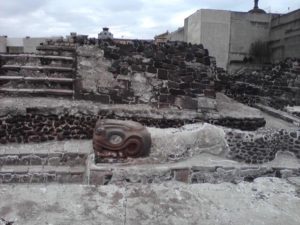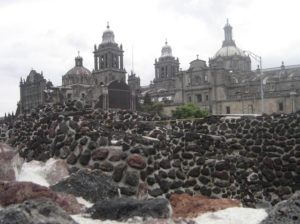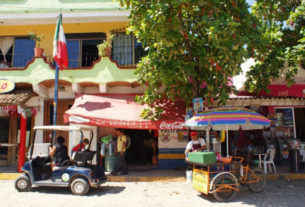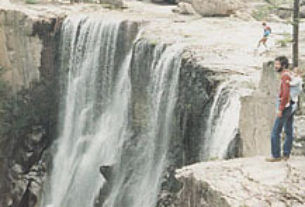Many cities worldwide have famous downtown squares, or plazas. Notable examples include London’s Trafalgar Square, Moscow’s Red Square and Beijing’s Tienanmen Square, among many others.
Such a plaza is an essential part of a city’s history and identity. Consequently, it is a major draw for tourists.
Mexico City’s principal plaza, called the Zócalo, fills such a role and is the heart of that great metropolis.
Origins and history
The Zócalo and its immediate area is where Mexico City began. It was originally an island on Lake Texcoco, settled in 1325 by the Aztecs. The exact spot where the city is said to have been founded is now marked by a statue of an eagle and serpent, just south of the plaza.
As the city and its empire expanded, this area remained at the center, the site of the emperor’s palace and principal temples.
Conquered in 1521 by the Spaniards and their indigenous allies, this same piece of real estate was rebuilt Spanish-style and became the seat of the Spanish viceroy.
In 1821, Mexico became independent and was ruled from this same place. Twice in the 19th century, the city was conquered by foreign troops, but even then, the Zócalo became their headquarters.
Throughout every period of Mexican history, throughout all the changes of regime and government, the Zócalo has been at the center of it all, for almost 700 years.
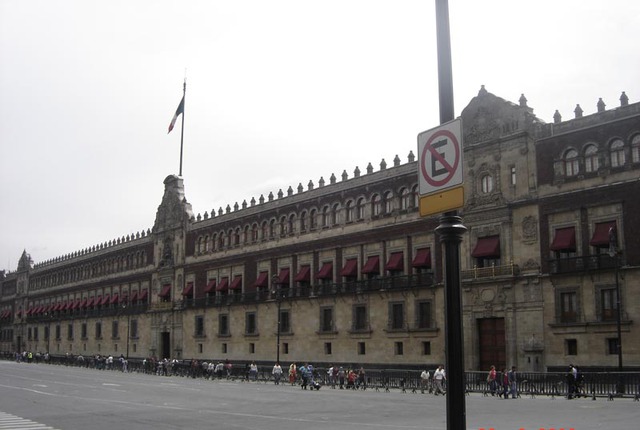
Did you know?
Architecturally, the Zócalo follows the Spanish plaza-style found in Spain and Latin America. A plaza is a square or rectangle at the heart of the city where the seat of government and a Catholic church are often located. It may be called the Plaza Mayor (Main Plaza) or Plaza de Armas (Plaza of Weapons), where the militia was mustered and drilled.
Mexico’s plazas are great tourist attractions. Though they follow the same basic layout, each has its own idiosyncratic identity. The biggest Mexican plaza of all is Monterrey’s Macroplaza, comprising nearly 100 acres.
The official name of Mexico City’s Zócalo Plaza is the Plaza de la Constitución, named for the Spanish Constitution of Cadiz. This constitution, drafted in 1812 during the Peninsular War, had a great influence on Latin American constitutions.
As for the term “zócalo,” it derives from Nahuatl, the language of the Aztecs and kindred peoples. It means “base” or “plinth,” referring to the base of a planned column which was never constructed. Though long-since removed, the name stuck as a designation for the plaza.
The Mexico City Zócalo has an area of about 14 acres. Standing at the flagpole in the middle, a visitor can turn his gaze in contemplation to each of the four cardinal directions and see a different portion of the Zócalo .
Around and beneath the Zócalo
To the east lies the Palacio Nacional, to the north the Cathedral, to the south the Federal District municipal buildings and to the west commercial buildings. The four sides thus represent four important forces in Mexico City.
The Zócalo also forms part of the city’s transportation network. The outer perimeter of the square has several lanes of traffic moving counter-clockwise. So be careful crossing!
In addition there is a Metro station under the plaza, conveniently entitled “Zócalo ,” making the plaza very accessible.
Palacio Nacional
The Palacio Nacional, on the square’s east side, is a couple hundred yards long. It was the site of the Aztec emperor Montezuma’s palace, which was seriously damaged in 1521 during the Conquest. Hernan Cortes rebuilt it as a fortress-style palace, which was later purchased from his family by the Spanish government and used as the viceroy’s palace. In the 1690s that building was burned. The palace was reconstructed in the early 1700s in pretty much its current form, though a third story was added in the 1900s.
The Palacio Nacional is a splendid example of old Spanish architecture. With its patios, colonnades and arches, it is both aesthetic and functional. The building was the seat of the Spanish viceroy, who governed, in the king’s name, the vast territory of Nueva España, stretching from California to Costa Rica.
Upon the country’s independence in 1821, the palace became the Mexican capitol building. For many years, it housed all three branches of government, serving as the president’s residence and the meeting places of Congress and the Supreme Court. Imagine that!
Twice during the 19th century, Mexico was occupied by foreign armies, whose military commands also recognized the building’s value.
Mexico City was occupied by the U.S. Army from September of 1847 to June of 1848, during which time the Palacio served as the headquarters of General Winfield Scott.
In 1863 the city was occupied by the French army. This occupation developed into the Empire of Maximilian, (1864 to 1867) who used the building as an administrative center.
From time to time in Mexican history, the Palacio was part of violent struggles for power, its strategic importance recognized by all factions involved.
During the 1800s, then-president Anastasio Bustamante was besieged within the Palacio for twelve days by the insurgent forces of Valentin Gomez Farias. During the Mexican Revolution of the early twentieth century, the building was fired upon.
The site has seen a lot of conflict, to be sure. But whether it was the seat of Aztec power, of the Spanish viceroy, the Mexican government, the U.S. Army, the French army, Maximilian‘s empire or the various factions in Mexico’s uprisings, civil wars and revolutions, the real estate on which the Palacio sits was right in the thick of things.
Today, the Mexican President no longer resides there, nor is it the seat of the Congress and Supreme Court. But the President still has official offices in the Palacio and various meetings are held here, including ceremonial functions and state visits. It’s also the headquarters of the finance ministry, and houses official archives and a military command.
Part of the building is open to tourists, including the main patio and the Diego Rivera murals.
Catedral Metropolitana de la Asuncion de Maria
On the Zócalo ‘s north side is the Metropolitan Cathedral, the Catedral Metropolitana de la Asunción de María, seat of the Archbishop of Mexico.
Mexican history has had its share of church-state conflict and yet there they are — the Cathedral and the Palacio in close proximity on the Zócalo , a microcosm of Mexican society.
The Cathedral replaced an earlier post-Conquest Spanish church which, in turn, had been built over the site of the Aztec temple precinct. The Cathedral was a work in progress for several centuries. Its foundation began to be laid in 1562 and construction began in 1573. It was finally completed in 1813.
The interior of the cathedral is a beehive of activity, combining religious ceremony, tourism and commerce in its various sections. Even as mass is being conducted, tourists gawk and snap photos, while a gift shop is simultaneously in operation. Nobody seems to mind. There is even a tour which takes visitors up on the roof to see the bells.
Around Mexico City’s Templo Mayor
Just off the Zócalo and northeast of the Cathedral is the Templo Mayor, site of the Aztec temple of Huitzilipochtli/Tlaloc. Destroyed in 1521, much of it has since been excavated. Visitors can see the temple’s remains, and artifacts discovered mostly onsite are on exhibit in the onsite museum.
The Zócalo and the buildings around it are steeped in history yet simultaneously throb with contemporary life and activity. It’s a destination for pedestrians, motorists, vendors, activists and tourists of various nationalities.
I recall my first visit to Mexico City and how fascinating I found the Zócalo to be.
On a later visit, my wife and I heard women there speaking Nahuatl, the language of the Aztecs, still a living tongue spoken in the city they founded 700 years ago.
Activities in the Zócalo
Mexico City’s Zócalo is also an important public space for gatherings.
One such assembly is the El Grito ceremony held on the night of September 15th. The president (or sometimes the mayor of Mexico City) stands on the balcony of Palacio Nacional, rings a bell, waves the flag and shouts “Viva México!”
The following day, the massive Independence Day military parade passes through the Zócalo , and the President reviews it from that same balcony.
Mexico’s colossal 2010 Centennial/Bicentennial celebration was held in the square.
The Zócalo is an open-air auditorium for campaign rallies and protest rallies. Groups of protesters will often camp out on the plaza for weeks on end.
The Zócalo is even a concert venue, having hosted international pop stars. In 2012, former Beatle Paul McCartney drew a quarter of a million spectators to the Zócalo .
The plaza has been the site of an enormous Rosca de Reyes, a special cake consumed on January 6th, Three Kings’ Day. In recent years, an ice skating rink has even been installed in the Zócalo over the Christmas vacations.
And on and on it goes.
Since 1325, this piece of real estate — in and around the Zócalo , where the city began — continues, after all the changes of government and technology, as the beating heart of this great metropolis.

